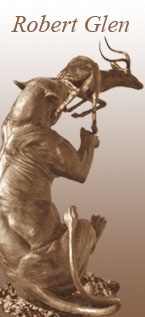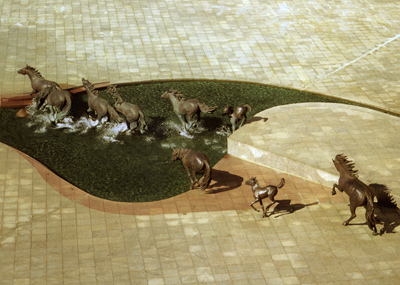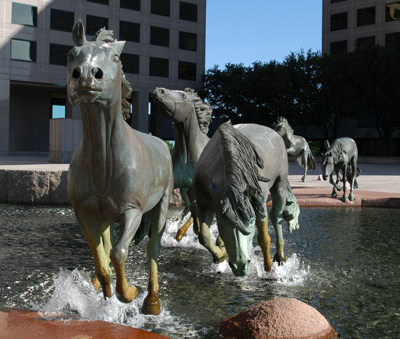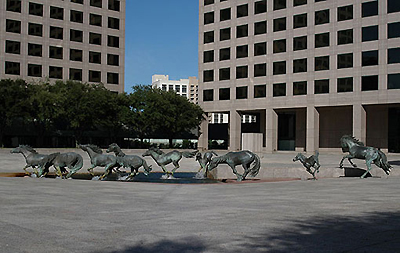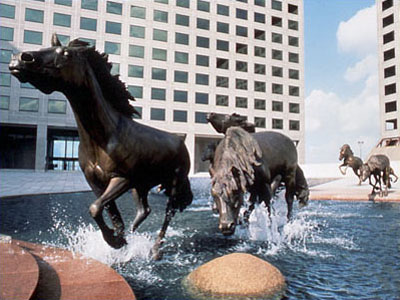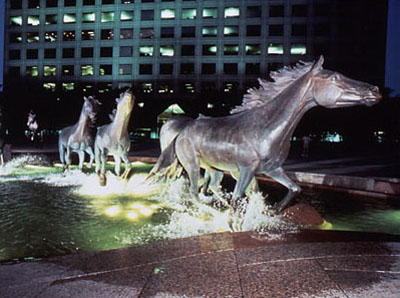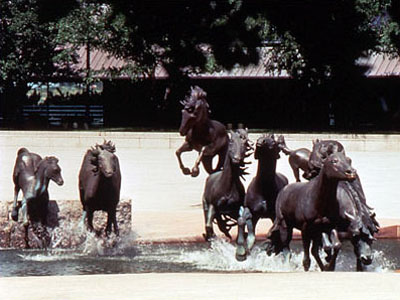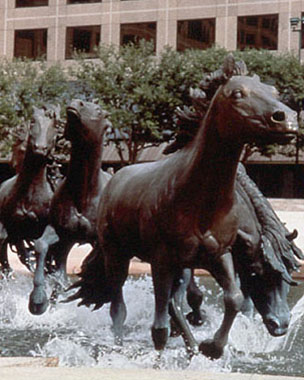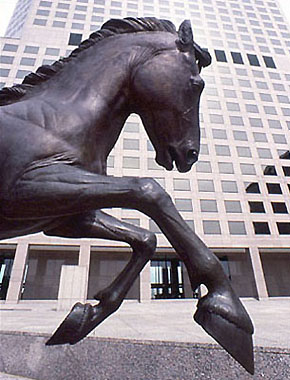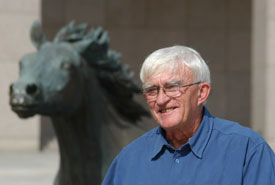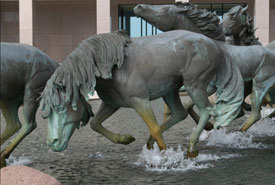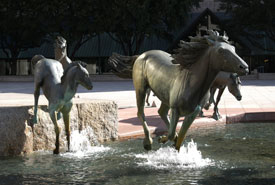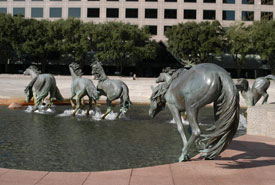| Sculptor
Robert Glen was commissioned to sculpt these nine mustang horses
which were placed in Williams Square, Las Colinas, Irving, TX. The
research for the authentic "Andalusian Horse" was done
in Spain, where evidence was found of the Spanish Conquistadores
taking horses to Texas and Mexico in the 17th century. Some of these
horses went wild and become known as Mustangs. The initial models
for this sculpture were made in Robert Glen's studio in Africa.
They were then cast in England and flown to Dallas, TX. The final
installation in Williams Square was completed in 1984.
The Mustangs of Las Colinas, a modern-day equestrian sculpture,
was planned and executed as a memorial to the evolving culture in
North America. This monumental sculpture memorializes the heritage
of Texas, recognizing that Texas is not only a geographical place
on this continent, but that it represents a distinctive spirit and
way of life of a people who are committed to the freedoms of action,
initiative, and expression for each individual man and woman as
no other culture before has exhibited. Texas is the land of the
entrepreneur, a citizenship of individuals, a land of the free spirit.
How
"The Mustangs of Las Colinas" Were Created
Robert Glen was given the assignment to create the mustang sculpture
in the summer of 1976. The plan for a large plaza, the size of two
football fields side by side, paved in Texas pink granite, was described
to him by Ben H. Carpenter, the developer of the project. He was
asked to create a band of mustangs crossing a stream of water in
the middle of the plaza proportioned so that they could be viewed
from any direction. The plaza would be bordered by granite clad
buildings on three sides with a fourth building possibly to be added
across the boulevard.
Glen spent a year of research prior to starting the actual sculpting
process. He read books and historical periodicals to fully understand
the background of the magnificent animals that were brought to the
American continents from Spain and which sired the original wild
horses of Texas and the western United States. He discovered that
the wild horses presently in the preserves and parks reflected subsequent
crossbreeding unlike the Spanish ancestry of the original mustangs.
Glen was sent to southern Spain in search of authenticity. There
he studied horses with the same pure bloodlines as those of the
specially selected animals taken to Mexico and Texas centuries before.
Following the same research techniques applied to his African wildlife
sculpture, Glen used a number of anatomical castings, taken from
dissected animals, to study the anatomy and muscular and skeletal
systems prior to beginning his sculpting.
First Glen constructed a number of small scale model horses in various
positions and movements reflecting the mood and motion of the concept
that had been given him. During this stage he made 47 different
models before a final scale model, less than 1/8 lifesize, became
a three-dimensional outline for the next stage of the sculpturing
process, as well as serving as a model around which the plaza design
details could be further developed. The next phase of the process
required that larger working models be made from which more accurate
measuring could be done. This intermediate state, modeled in a pliable
plasticine material, was fashioned by Glen at 1/2 of lifesize, which
would be 1/3 of the final 1 1/2 times lifesize monument.
Modeling was done in plasticine, considered an improved material
over clay for this type of work, to facilitate greater detailing.
Since plasticine is a soft and easily damaged material Glen made
molds of each of the 1/3 final size animals he had created in his
studio and cast them in fiberglass. This intermediate stage, in
the form of a fiberglass maquette, would ultimately be shipped from
Glen's Nairobi studio to the foundry in England where the final
1 1/2 lifesize models would be completed and cast. Glen used a mixture
of fiberglass and resin in which to cast a lightweight yet durable
model that would endure the trip from Nairobi to England. The Nairobi
studio was the site of this repetitive process for each of the nine
mustang animals that would compose the completed sculpture; five
mares, two colts, a young stallion, and an older stallion dominating
the band of mustangs. The fiberglass maquettes were cleaned and
prepared for shipment to England. Glen made finishing touches to
each of the fiberglass maquettes. Prior to shipping from Nairobi
the preciseness of the detailing of hair, mane, nostrils, and the
muscular appearance of the surface of the maquette was carefully
checked.
Each
fiberglass intermediate size maquette was crated and shipped by
air from Nairobi to the Morris Singer Foundry at Basingstoke, England,
about an hour's drive from central London. This world famous foundry
has cast the works of such famous sculptors as Jacob Epstein, Hamo
Thornycroft, Barbara Hepworth, Dora Gordine, Oscar Nemo, Enzo Piatta,
David Wynne, Henry Moore, Reg Butler, Eduardo Paolozzi, and Kym
Chadwick. Periodically, Glen flew to England and spent several months
at a time in the foundry where the final process of creating the
1 1/2 lifesize model was begun, using the intermediate size maquette
as a scaling and measurement guide to be cast in bronze.
The enlargement of realistic forms such as the mustangs is a complex
process dealing with the volumetric problems brought on by varying
forms and densities. A three-dimensional pantograph was constructed
to produce the enlarged models. Using the pantograph, a "cut
out" in a light foam material was assembled and fitted to a
metal frame or armature. The shape formed by these assembled "cut
outs" were purposely slightly undersized so as to provide a
reasonably accurate enlarged form in the shape of the intermediate
maquette but providing a modeling surface upon which a final coating
of plasticine could be applied and sculpted.
The plasticine coating covers the armature form which was created
by the pantograph and enlarged to three times the size of the intermediate
size maquette shipped from Nairobi. The completed plasticine model
of the young stallion hangs suspended within a frame, awaiting the
next step, preparation for final mold making preceding the actual
bronze casting. Each horse, when completed, had one to one and one-half
tons of plasticine on its frame and the armature weighed about half
a ton. The bronze casting required that each of the final sculpted
animals be cut into several sections. Therefore, the surface of
the soft plasticine modeling material had to be made firm so that
it could be handled during the cutting and strong enough to go through
the mold-making process. Robert Glen devised a simple system of
painting thickened polyester resin over the completed plasticine
surface which hardened in about fifteen minutes. This also preserved
in its final form the impression of hair created by delicate brush
strokes applied to the plasticine surface in the final detailing
process. Later in this process the cast bronze tail will be united
with the other sections of the casting which compose the animal.
Each portion of the final model was packed in silica sand within
a sectional steel box.
The silica sand compound containing a small percentage of water
and sodium citrate is set to the consistency of sandstone by permeation
with CO2 gas. The reaction of the ingredients in the sand with the
gas hardens into a reverse or negative mold around the model within.
When the steel sections of the box are dismantled the hardening
sand mold around the plasticine model is removed. These reverse
sand molds are fitted together within another steel box, leaving
a hollow void where the model had been located in the first steel
box. This hollow void is then filled with sand, which in turn is
hardened by the gas permeation technique producing a positive solid
core mold of the maquette.
The internal solid core positive mold of sand is trimmed to an undersized
shape in order that when it is fitted back together with the corresponding
negative sand mold a gap of open space will exist between the two.
Steel pins are used to maintain proper spacing of the relationship
between the positive and negative molds of hardened sand. Then molten
bronze, heated to a temperature of 1150 degrees, is poured into
the open gap between the two sand molds. When cooled, the casting
is exposed by removing the metal casing and smashing away the sand
mold. Not until this point was it known that the cast was a good
one.
Following removal from the sand mold box, the bright bronze metal
castings were examined, cleaned, and touched up. Metal finishing
removed any excess bits of bronze from the edges and each bronze
piece was prepared and assembled for welding together with other
sections of the sculpture. Bronze welding was used to chase all
seams together for a unified surface. In one case, a tail was cast
in no less than 34 separate pieces and then welded together. During
this process, Glen was joined by foundry managing director David
Vallance and foundry superintendent Arthur Markwell in supervising
the final assembly of the castings. Bronze welding was done both
inside and outside each section. The Morris Singer Foundry, whose
heritage includes the casting of public monuments around the world
such as the famed Lions of London's Trafalgar Square, is one of
the oldest continuing sculpture foundries in the world. Founded
in 1848 by John Webb Singer, utilizing British, French and Belgian
artisans, it was merged in 1927 with the Morris Art Bronze Foundry
and in 1973 with the Paris sculpture foundry, Susse Fondeure S.A.
In addition to sand molding, another ancient and time consuming
process is the assemblage and finishing of the resulting bronze
castings. The few experts for large scale castings available today
have studied and worked in it most of their lives. Foremost among
them are the artisans at the Morris Singer Foundry.
The bright and shining bronze mustang castings were assembled in
the foundry yard one by one as they were completed. The five mares
and young stallion were to be joined later by the two colts and
the older stallion. These bronze figures, however, form only a portion
of the sculptural presentation. At this stage they are yet to be
united with the granite clad environment in which they will be permanently
situated within the moving stream designed to enforce and accentuate
the perspective of motion and movement.
The bronze casting process itself was completed on November 10,
1981. The London firm of Evan Cook was engaged to prepare the bronze
sculptures for shipment to Texas. A decision was made to make the
shipment by air rather than by ocean. At the Basingstoke foundry
each bronze sculpture, weighing approximately two tons, was loaded
and taken to Cook's packing warehouse. There, specially designed
crates for each individual horse were installed to protect them
en route. They were then transported to Heathrow Airport outside
London.
At Heathrow Airport the 17-ton cargo of nine bronze mustangs was
loaded onto a Pan American Airways 747 cargo plane and flown across
the Atlantic to Kennedy Airport in New York City. Las Colinas Corporation
sent a representative to accompany the sculpture while they were
in transit. In New York, the bronze horses were transferred to an
American Airlines 747 freighter which flew the cargo to Dallas/Fort
Worth International Airport, adjacent to Irving. Upon arrival at
D/FW Airport, the cargo of mustangs was unloaded from the plane
and brought overland to Las Colinas. Meanwhile, during the several
years in which the sculpture pieces were being created, enlarged,
cast and finished in bronze, the architectural firm of Owings, Skidmore,
and Merrill had been engaged to design the complex of buildings
which would surround the plaza. The complex of granite-clad, copper-roofed
buildings, designed by Charles Bassett, a principal in the San Francisco
office of the architectural firm, was well under construction and
partially occupied at the time of the arrival of the bronze mustangs.
In a nearby staging area the mustangs were assembled in a mock-up
of elevations and positioned as they would relate one to another
on the plaza. Meanwhile, James Reeves, the landscape architect and
planning engineer, had designed the layout plan for the stream in
the middle of the plaza that the horses would be crossing. An 8,000
pound concrete plinth was made as a base for each horse. An intricate
pumping system was designed to suggest the splashing of water around
the hooves of the horses, crossing in midstream. Following the installation
of the horses in the stream the piping for the water and fountain
system was completed and the bottom of the stream bed was covered
with a pebble-like finish.
The last stages of the installation were carefully supervised by
Glen. Specialists from the Morris Singer Foundry flew to Texas to
assist in cleaning the bronze surface of the installed horses by
blasting the sculptures with tiny particles of plastic under high
pressure. This process returns the bronze to the gold-brass coloration
it had as it emerged from the molds at the foundry. In earlier years
people tried to retain the bright new look of bronze. In more recent
times, however, the vogue has been to rapidly influence the oxidation
or patination of bronze sculpture by inducing with acid mixtures
a specifically designed coloration or effect. It was decided not
to chemically induce an accelerated oxidation on the mustang pieces,
but instead to permit them to age naturally, evolving their patina
over time, responding to the natural environment as God will have
it. Periodically the bronzes are coated with a thin wax material
to minimize an accelerated discoloration.
Finally, on September 25, 1984, eight years after the project was
conceived, the sculpture was in place and the plaza was open for
the public to inspect and enjoy. Assembled together at last were
the nine bronze mustangs, forming the largest equestrian sculpture
in the world. The plaza has become a place for public gatherings,
symphony concerts, and other intellectual and recreational pursuits.
The centerpiece of the plaza, "The Mustangs of Las Colinas",
shall be a lasting memorial to the vanguard of the civilization
of Texas.
Robert Glen thanks the Dallas County Utility and Reclamation District
for its courtesy in allowing this article to be reproduced. ©1988
Dallas County Utility and Reclamation District |



